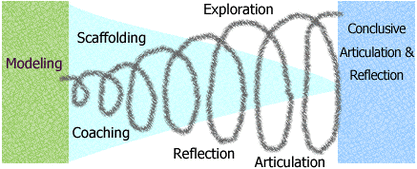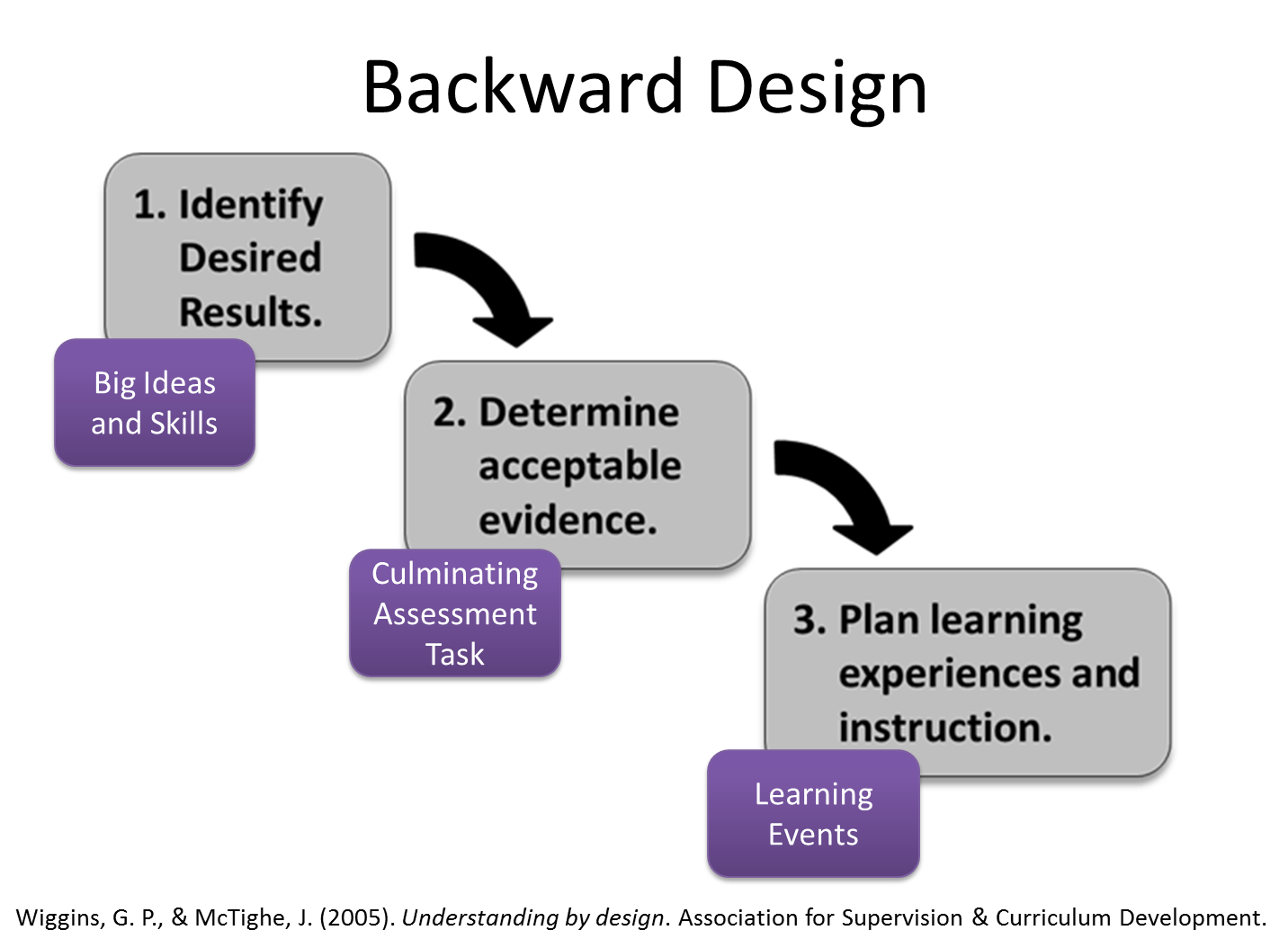What else is social studies?
An in-depth look at the anti-bias curriculum.
 As a future educator of social studies, it is my responsibility to promote students’ civic competence considering that: “The primary purpose of social studies is to help young people develop the ability to make informed and reasoned decisions for the public good as citizens of a culturally diverse, democratic society in an interdependent world” (National Council for the Social Studies, 1994, p. 3). To fully prepare students to engage in their roles as global citizens in a “culturally diverse, democratic society in an interdependent world,” students must be provided with authentic experiences that challenge them to appreciate differences in their peers’ cultures and perspectives. Thus, teachers become responsible for providing students with these experiences so that they may lead students to analyze the inaccuracies and stereotypes within their own thinking and what they have been told, considering that “prejudice is contagious” (Anti-Defamation League, 2000). Failing to prevent the early formation of prejudicial attitudes in the elementary grades, when prejudice is at its most vulnerable, increases the likelihood that students will embark upon a life-long path of hate and violence: “Stereotyping, prejudice, discrimination, bias, and hate are part of a broad continuum of behavior. Along that continuum are a number of negative behaviors, including bullying, threats, exclusion, harassment, bias-motivated behavior, and hate-motivated violence” (Partners Against Hate, 2001, p. 9). Exercising the inquiry process, I have explored how to incorporate anti-bias instruction into the social studies curriculum, and uncovered activities that can be utilized to impede the hate escalation continuum, and foster appreciation for diversity instead. Therefore, this assignment has expanded my content knowledge of what social studies entails, underscored the value of controversial discussions and cooperative learning to promote civic competence, and developed my pedagogical knowledge of how to target anti-bias and cultural appreciation domains in my future classroom.
As a future educator of social studies, it is my responsibility to promote students’ civic competence considering that: “The primary purpose of social studies is to help young people develop the ability to make informed and reasoned decisions for the public good as citizens of a culturally diverse, democratic society in an interdependent world” (National Council for the Social Studies, 1994, p. 3). To fully prepare students to engage in their roles as global citizens in a “culturally diverse, democratic society in an interdependent world,” students must be provided with authentic experiences that challenge them to appreciate differences in their peers’ cultures and perspectives. Thus, teachers become responsible for providing students with these experiences so that they may lead students to analyze the inaccuracies and stereotypes within their own thinking and what they have been told, considering that “prejudice is contagious” (Anti-Defamation League, 2000). Failing to prevent the early formation of prejudicial attitudes in the elementary grades, when prejudice is at its most vulnerable, increases the likelihood that students will embark upon a life-long path of hate and violence: “Stereotyping, prejudice, discrimination, bias, and hate are part of a broad continuum of behavior. Along that continuum are a number of negative behaviors, including bullying, threats, exclusion, harassment, bias-motivated behavior, and hate-motivated violence” (Partners Against Hate, 2001, p. 9). Exercising the inquiry process, I have explored how to incorporate anti-bias instruction into the social studies curriculum, and uncovered activities that can be utilized to impede the hate escalation continuum, and foster appreciation for diversity instead. Therefore, this assignment has expanded my content knowledge of what social studies entails, underscored the value of controversial discussions and cooperative learning to promote civic competence, and developed my pedagogical knowledge of how to target anti-bias and cultural appreciation domains in my future classroom.

Prior to my inquiry journey exploring anti-bias and anti-violence curriculum, I understood that prejudicial attitudes were typically passed down generationally within families and were largely the result of ignorance, unfamiliarity, and fear. However, I minimized the role teachers can play in challenging prejudices and curbing their development in such young children: “Both the seeds of respect and the seeds of intolerance are planted when children are very young and nurtured by their experiences and by the attitudes of those around them as they grow” (Partners Against Hate, 2001, p. 25). Similarly, Caryl Stern of the Anti-Defamation League asserts: “No child is born a bigot. Hate is learned and there is no doubt it can be unlearned.” Recognizing that, “after age 9, racial attitudes tend to stay the same unless the child has a life-changing experience,” I now can appreciate the critical importance of specifically teaching the main tenets and emphasizing the essential questions that come with anti-bias curriculum (Aboud, 1988). The essential questions of the anti-bias curriculum that I think are most important, and even incorporate and weave in some of the global education and character formation curriculum that my colleagues discussed, include: How is prejudice different from dislike? How does humanity as a whole benefit when people from all backgrounds are appreciated and included? How does hate influence negative behavior, and why does this harm our global community? Specifically, my inquiry process has led me to generalize, as I expressed in my presentation, that the highest form of anti-bias, the goal teachers should have for all students, is appreciation of differences: “We can learn to respect differences, to see them as a source of strength in our lives and society, even celebrate them” (Anti-Defamation League, 2000).
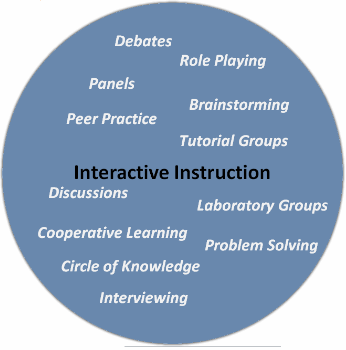 To develop this appreciation, which goes hand-in-hand with students reaching the highest level of civic competence, students must be provided with genuine opportunities to determine for themselves why diversity is something to be valued as opposed to hated. Prior to this inquiry process, I was most familiar with teachers directly telling students that hate, bullying, and prejudice are wrong, and this having limited benefits. At most, I felt that this approach following the behavioral model could accomplish tolerance as students come to find that any prejudice at school will not be allowed. Research has confirmed my hypothesis, and overwhelmingly advocated that activities falling within a combination of the other three models of instruction – information processing, social interaction, and personal – are superior in promoting the ultimate goal of the anti-bias curriculum: to foster appreciation of cultural diversity. In particular, the cooperative learning method is celebrated for showing “consistently positive effects on student achievement, conflict reduction, and intergroup relations. Of particular interest in the area of interrelationships, students who experience cooperative learning techniques have shown gains in friends of different backgrounds and have made more positive attributions to other groups” (Partners Against Hate, 2000, p. 43). By having students engage in tasks cooperatively, and more specifically, challenging students to engage in cooperative problem solving in which an interpersonal conflict must be resolved utilizing a non-confrontational framework, students are required to confront their prejudices and adjust them in light of new information (Four Worlds Development Project, 1988). In other words, positive interaction breeds improved relations.
To develop this appreciation, which goes hand-in-hand with students reaching the highest level of civic competence, students must be provided with genuine opportunities to determine for themselves why diversity is something to be valued as opposed to hated. Prior to this inquiry process, I was most familiar with teachers directly telling students that hate, bullying, and prejudice are wrong, and this having limited benefits. At most, I felt that this approach following the behavioral model could accomplish tolerance as students come to find that any prejudice at school will not be allowed. Research has confirmed my hypothesis, and overwhelmingly advocated that activities falling within a combination of the other three models of instruction – information processing, social interaction, and personal – are superior in promoting the ultimate goal of the anti-bias curriculum: to foster appreciation of cultural diversity. In particular, the cooperative learning method is celebrated for showing “consistently positive effects on student achievement, conflict reduction, and intergroup relations. Of particular interest in the area of interrelationships, students who experience cooperative learning techniques have shown gains in friends of different backgrounds and have made more positive attributions to other groups” (Partners Against Hate, 2000, p. 43). By having students engage in tasks cooperatively, and more specifically, challenging students to engage in cooperative problem solving in which an interpersonal conflict must be resolved utilizing a non-confrontational framework, students are required to confront their prejudices and adjust them in light of new information (Four Worlds Development Project, 1988). In other words, positive interaction breeds improved relations.
 Also, while in the throes of researching for this presentation, I attended a seminar entitled, “Building Bridges for Our English Language Learners through the Introduction and Analysis of Latino Literature,” given by Karen H. Dakin and Jenice Mateo-Toledo. While they did not explicitly claim to be presenting on anti-bias curriculum, I quickly recognized that their presentation aimed at incorporating quality multicultural literature and analyzing how literature changes with culture, meets not only standards for English Language Arts but also works toward fostering a better appreciation and understanding of cultural differences. The seminar taught me that selecting literature written by cultural insiders that challenges dominant stereotypes provides students a “greater self-awareness and greater understanding of others, a more realistic view of the world, and the ability to use what they have learned to make meaningful changes in their own lives” (Ada, 2003, p. 84). The Partners Against Hate confirm that, “Children’s literature serves as both a mirror to children and as a window to the world around them by showing people from diverse groups playing and working together, solving problems, and overcoming obstacles” (2001, p. 36). Consequently, the Partners Against Hate demand that: “Because there is such a relatively small number of children’s books about people of color, people who are gay and lesbian, or people with physical and mental disabilities, it is extremely important that adults make every effort to see that high-quality children’s literature by and about these groups is made available to children” (2000, p. 36). Through this “window,” students’ empathy and appreciation for cultural diversity can be increased while fear of the unknown is decreased.
Also, while in the throes of researching for this presentation, I attended a seminar entitled, “Building Bridges for Our English Language Learners through the Introduction and Analysis of Latino Literature,” given by Karen H. Dakin and Jenice Mateo-Toledo. While they did not explicitly claim to be presenting on anti-bias curriculum, I quickly recognized that their presentation aimed at incorporating quality multicultural literature and analyzing how literature changes with culture, meets not only standards for English Language Arts but also works toward fostering a better appreciation and understanding of cultural differences. The seminar taught me that selecting literature written by cultural insiders that challenges dominant stereotypes provides students a “greater self-awareness and greater understanding of others, a more realistic view of the world, and the ability to use what they have learned to make meaningful changes in their own lives” (Ada, 2003, p. 84). The Partners Against Hate confirm that, “Children’s literature serves as both a mirror to children and as a window to the world around them by showing people from diverse groups playing and working together, solving problems, and overcoming obstacles” (2001, p. 36). Consequently, the Partners Against Hate demand that: “Because there is such a relatively small number of children’s books about people of color, people who are gay and lesbian, or people with physical and mental disabilities, it is extremely important that adults make every effort to see that high-quality children’s literature by and about these groups is made available to children” (2000, p. 36). Through this “window,” students’ empathy and appreciation for cultural diversity can be increased while fear of the unknown is decreased.
Thus, the anti-bias curriculum goal of leading students to appreciate differences among cultures as opposed to progressing down a continuum of hate that leads to bullying and violence targets the first theme of the National Curriculum Standards for the Social Studies: Culture. Through this curriculum, “students will acquire knowledge and understanding of culture through multiple modes, including fiction and non-fiction, data analysis, meeting and conversing with peoples of divergent backgrounds, and completing research into the complexity of various cultural systems” (NCSS). Similarly, the curriculum integrates New York state social studies and English Language Arts standards across all grade levels. For example, a lesson emphasizing peaceful conflict resolution using a cooperative problem solving method within the social interaction model of instruction targets the Common Core sixth-grade social studies civic participation standard: “Participate in negotiating and compromising in the resolution of differences and conflict; introduce and examine the role of conflict resolution.” Similarly, an anti-bias lesson using multicultural literature as described above would meet the sixth-twelfth grade New York State Common Core Career and College Readiness Standard for Reading 11: Students will “Respond to literature by employing knowledge of literary language, textual features, and forms to read and comprehend, reflect upon, and interpret literary texts from a variety of genres and a wide spectrum of American and world cultures.”
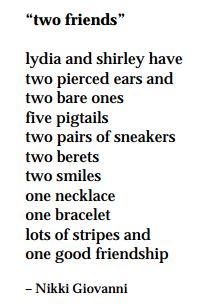
As I explained in detail in my glogster presentation, to target these and other standards, as well as integrate anti-bias curriculum with the disciplines of social studies and other content areas, Partners Against Hate present a plethora of activities for all grade-levels. For kindergarten and first-graders, I would suggest beginning by exploring differences and how they are not essentially bad, which will hopefully help to prevent students from making rash judgments of the unknown later in life. To explore differences, students can read a poem by Nikki Giovanni titled “Two Friends.” By analyzing this poem, students can make the generalization that people can have differences between them and still be friends. Second and third-graders can engage in an anti-bias curriculum research project by interviewing their parents and relatives about their own culture and sharing these stories with the class. The teacher can then promote communication and bridge-building by asking students to identify at least one similarity between their family’s story and a classmate’s family story. Fourth and fifth-graders should focus on exploring the difference between prejudice and dislike and the harmful effects of intolerance and violence. In this way, the anti-bias curriculum can be taught in conjunction with both historical accounts, utilizing primary documents, and present-day accounts, using non-fiction world news articles like those on Newsela, of intolerance and violence. A Partners Against Hate activity (2001, p. 71) that addresses the essential question regarding the difference between prejudice and dislike is to have students act out different scenarios, and then evaluate whether prejudice or simply dislike is present in the conflict.
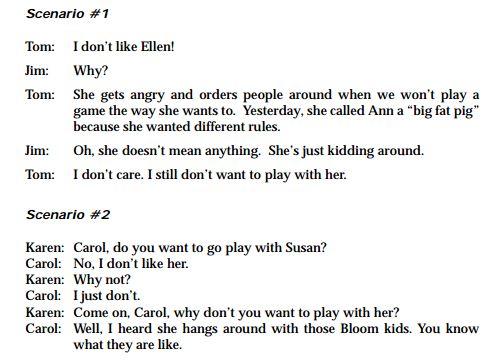
Other anti-bias activities can be utilized and adapted for students in upper elementary, middle school, and high school grades. An activity with which I was familiar before researching this assignment was having students draw pictures of a certain population before receiving instruction about that group. Typically, many students will draw pictures incorporating stereotypes about the given population. In fact, when I participated in this activity at a recent workshop for teachers and teacher candidates, I was surprised to find that many educated adults still fell into the trap of stereotyping when asked to draw a Native American. While this activity is typically succeeded by a multicultural book about the population to alter students’ perceptions, I think the lesson would be even more powerful if teachers could arrange through Skype for students to interact with the given population from another place in the world or a person of that culture who transcends a negative stereotype, whichever is more appropriate for the given population. Students can then form the generalization that stereotypes inaccurately label individuals, and that they should interact with individuals to learn about them, not trust what they have heard from others.
 As can be seen from all of these examples, it is critical to the anti-bias curriculum, as with all curricula, that students actively engage the material with peers of heterogeneous backgrounds, make personal connections to the material, and form generalizations that are meaningful to them. Overall, students must be provided with opportunities to progress through the inquiry process to explore examples of both hate-based and appreciation-based behaviors in history and presently. This will allow students to form generalizations about the side-effects of those actions, and apply these new understandings to their own lives and how they perceive their peers. As I explained in my presentation, students who develop appreciation for differences through reasoning as opposed to biased opinions passed down from ignorant adults or fear of the unknown are far less likely to employ cyber-bullying or hate-based violence. This is why I chose to emphasize the formation of appreciation, as opposed to the side-effects of not instilling it in students. Most importantly, the cultivation of appreciation, the ideal for which the anti-bias curriculum strives, cannot be taught through a behavioral model of instruction. Students must discuss the information, have their own views challenged, and connect personally in order for the curriculum to be successful in exterminating the “racial attitudes that begin to harden by the fourth-grade” (Partners Against Hate, 2001, p. 16). As students are learning, there will be instances in which students express prejudices. While it is important that these hurtful ideas be corrected, it is more important that students understand why they are incorrect in the first place: “Telling the children that their behavior is hurtful and inappropriate is certainly in order, however, without explaining why, little learning will take place” (Partners Against Hate, 2001, p. 31). Students must be challenged to think beyond the stereotypes and prejudices that they have previously encountered, and form the generalizations that appreciation of all groups leads to a better world and that people of all cultures are more the same than different, through participation in activities that fall within the scope of the information processing, personal, and social interaction models of instruction.
As can be seen from all of these examples, it is critical to the anti-bias curriculum, as with all curricula, that students actively engage the material with peers of heterogeneous backgrounds, make personal connections to the material, and form generalizations that are meaningful to them. Overall, students must be provided with opportunities to progress through the inquiry process to explore examples of both hate-based and appreciation-based behaviors in history and presently. This will allow students to form generalizations about the side-effects of those actions, and apply these new understandings to their own lives and how they perceive their peers. As I explained in my presentation, students who develop appreciation for differences through reasoning as opposed to biased opinions passed down from ignorant adults or fear of the unknown are far less likely to employ cyber-bullying or hate-based violence. This is why I chose to emphasize the formation of appreciation, as opposed to the side-effects of not instilling it in students. Most importantly, the cultivation of appreciation, the ideal for which the anti-bias curriculum strives, cannot be taught through a behavioral model of instruction. Students must discuss the information, have their own views challenged, and connect personally in order for the curriculum to be successful in exterminating the “racial attitudes that begin to harden by the fourth-grade” (Partners Against Hate, 2001, p. 16). As students are learning, there will be instances in which students express prejudices. While it is important that these hurtful ideas be corrected, it is more important that students understand why they are incorrect in the first place: “Telling the children that their behavior is hurtful and inappropriate is certainly in order, however, without explaining why, little learning will take place” (Partners Against Hate, 2001, p. 31). Students must be challenged to think beyond the stereotypes and prejudices that they have previously encountered, and form the generalizations that appreciation of all groups leads to a better world and that people of all cultures are more the same than different, through participation in activities that fall within the scope of the information processing, personal, and social interaction models of instruction.

References
Aboud, F. (1988). Children and prejudice. Oxford, OX, UK: B. Blackwell.
Ada, A.F. (2003). A magical encounter: Latino children’s literature in the classroom. Boston, MA: Allyn and Bacon.
Dakin, K., & Mateo-Toledo, J. (Speakers) (2015, April 18). Building bridges for our English language learners through the introduction and analysis of Latino literature. 22nd Annual Conference on Literacy. Lecture conducted from Collaborative for Equity in Literacy Learning, Newburgh, NY.
Four Worlds Development Project. (1988). Unity in Diversity Curriculum Guide. Lethbridge: Four Worlds Development Project, University of Lethbridge.
LaRosa, C. (2000). The Anti-Defamation League's hate hurts: How children learn and unlearn prejudice. New York, NY: Scholastic.
National Council for the Social Studies. (1994). Expectations of Excellence: Curriculum Standards for Social Studies. Washington, D.C.: NCSS.
National Council for the Social Studies. (n.d.). National curriculum standards for social studies. Retrieved April 28, 2015, from http://www.socialstudies.org/standards/strands
New York State Education Department. (2011). New York State P-12 Common Core learning standards for ELA and literacy. Retrieved April 28, 2015, from https://www.engageny.org/resource/new-york-state-p-12-common-core-learning-standards-for-english-language-arts-and-literacy
New York State Education Department. (2015). New York State K-12 social studies framework. Retrieved April 28, 2015, from https://www.engageny.org/resource/new-york-state-k-12-social-studies-framework
Partners Against Hate. (2001). Program activity guide: Helping children resist bias and hate. Retrieved April 25, 2015, from http://www.partnersagainsthate.org/publications/pahprgguide302 .pdf











